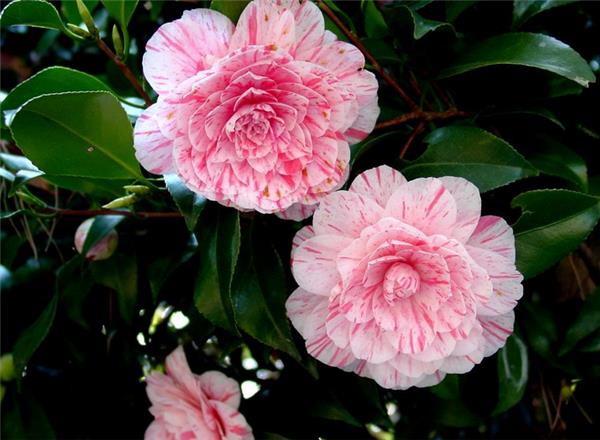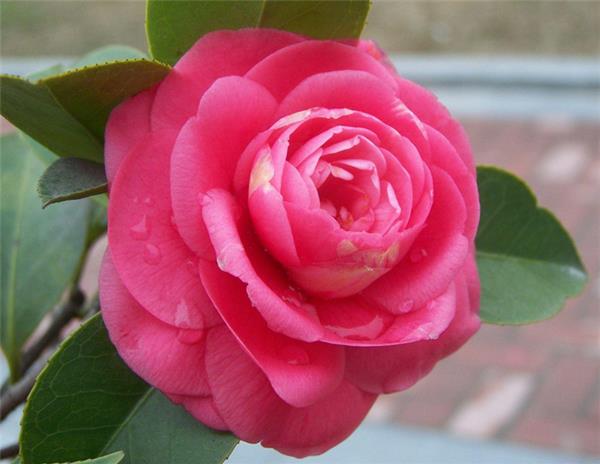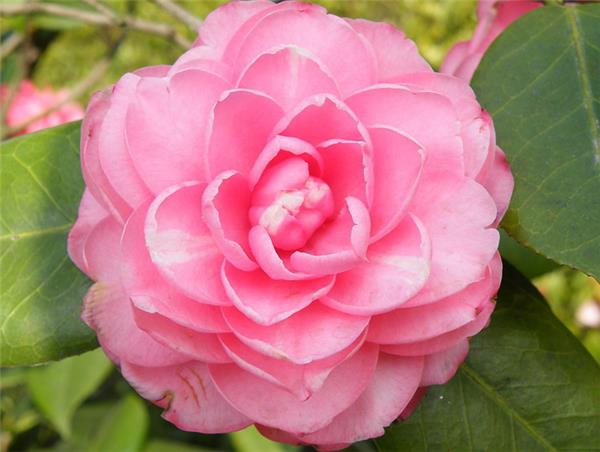What about the camellia buds?
In the cultivation of any flowers, there will be problems, the cultivation of camellia is no exception, camellia bud how to do? Let's take a look at the reasons for the bud drop of camellia and its solutions.

What about the camellia buds?
Reasons for bud drop of camellia: 1. Thinning buds
If there is no improper maintenance of camellia, the reason for the bud of camellia is to sparse buds, some people think that too many buds is good, in fact, too many buds are bound to disperse nutrients, resulting in buds falling off due to lack of nutrition.
Solution: around August, camellia buds should be thinned in time when they are the size of soybeans, and only one well-developed bud is retained in a branch, especially on weaker plants.
Reasons for bud drop of camellia: 2. Soil discomfort.
Soil discomfort is also one of the reasons for camellia budding. Sandy soil with pH value of 5-6.5 is more suitable for camellia growth. Excessive acid or humus, clayey soil, saline-alkali soil, calcareous soil and so on will make camellia grow poorly, and some trace elements can not be absorbed. The lack of phosphorus, iron, sulfur and other nutrients in the soil will also form the phenomenon of green deficiency and bud drop.
Solution: camellia buds caused by soil discomfort should be sprayed with 0.2% ferrous sulfate solution every week.
Reasons for bud drop of camellia: 3. Improper watering
Camellia like to be moist, avoid stagnant water, the root soil is too wet for a long time, it will suffocate the roots, light buds will fall, heavy will die. In order to protect the bud, it is necessary to keep the basin soil moist and slightly dry. If it is too dry, the fleshy fibrous root will be dehydrated and withered; if it is too wet, the fibrous root will die of suffocation and decay. When there is no water supply, the plant will drop its buds first and then its leaves.
Solution: if the basin soil has been too dry, you should first water a small amount of water, so that the basin soil is gradually moist, and then pour water thoroughly, otherwise the root tip will lose water, the big water will not be able to adapt, and you must drop buds. It is not watered until it is about 70% dry in winter, and warm water is needed at noon on a sunny day.

Reasons for bud drop of camellia: 4. The temperature is not good.
Poor temperature is another reason for bud drop of camellia. It is suitable to keep 3 ℃ ~ 5 ℃ during overwintering. If it exceeds 16 ℃, it will sprout ahead of time and cause deciduous buds. Below 0 ℃, the buds will freeze. The temperature in the early stage of flowering is not lower than 5 ℃ ~ 7 ℃, and the temperature in the period of flowering is 10 ℃ ~ 15 ℃. The highest temperature is 20 ℃. If the temperature is more than 2 ℃ in winter, the buds can be preserved. Camellia most avoid the temperature difference is too large, sometimes high temperature, sometimes low temperature, the buds will all fall off.
Solution: when the air temperature is close to 0 ℃, move the camellias to the indoor light place, cover the curtain at night to keep warm, and pay attention to adjust the temperature of the flower room to give the camellia the most suitable growth temperature.
Reasons for bud drop of camellia: 5. Poor ventilation.
Camellia bud drop is sometimes caused by poor ventilation, especially in winter, long-term indoor, poor ventilation, dirty air or room temperature more than 20 ℃, will also cause buds and leaves.
Solution: when maintaining the most suitable growth temperature of camellia, we should also pay attention to ventilation and ventilation, which can be put in the window to blow properly.
Reasons for bud drop of camellia: 6. Fertilization in winter
Camellia will enter the dormant period in winter, in the dormant period is not suitable for fertilization, even if the application of thin fertilizer is also easy to drop buds.
Solution: from early spring to before flowering, mixed liquid fertilizer of nitrogen and phosphorus can be applied twice to prevent bud falling, but nitrogen fertilizer should not be too much. If you should store enough nutrients for flowering in autumn, you can blossom with colorful flowers. From September to October, thin fertilizers with high phosphorus content, such as rotten chicken manure, were applied every month to achieve the purpose of strengthening buds. Stop fertilizing in November and do not apply fertilizer during the winter dormant period.
Reasons for bud drop of camellia: 7. Pest infection
The diseases of Camellia include anthracnose, coal pollution, gray spot and so on, among which anthracnose is the most serious. The pests are mainly scale insects. When it is found that diseases and insect pests should be sprayed and controlled in time, otherwise serious bud drop will occur.
Solution: anthrax damage can be sprayed with equal volume Bordeaux solution or 1000 carbendazim wettable powder, and shell pests can be sprayed or washed clean with 1000 times omethoate EC.

Matters needing attention in Camellia Culture
(1) be careful not to expose camellias to the hot sun
Camellia is a half-yin and half-yang environment, like warm and humid. The optimum temperature for camellia growth is 15-25 ℃, so it is suitable to be planted in areas with semi-overcast or astigmatism in summer, full light in the south and wind barriers in the north. Spray water mist on and around the branches and leaves at high temperatures in summer to cool down and prevent dryness. Shading should be carried out from June to September.
(2) be careful not to change the orientation of camellias at will.
The adaptability of camellia is poor, and the orientation of camellia can not be changed at will during the budding and budding period from April to September, so as to avoid the leaves on the shady side suddenly wither and fall in contact with strong light.

(3) be careful not to cultivate camellias in alkaline soil.
The root flesh of camellia is fragile, so it is necessary to use slightly acidic soil with loose soil and good drainage. Clayey and alkaline soil are not suitable, let alone calcareous soil. And the basin soil had better be changed once in 2023, pay attention to the base fertilizer at the bottom of the basin when changing the basin, and a small amount of superphosphate can be used, such as hair, bone powder, chicken feathers, birds and so on. It is better to choose the time to change the basin between "Rain Water" and "the Beginning of Summer".
(4) be careful not to water the camellias too much and apply too much fertilizer.
Camellia is a fleshy root, too much water is easy to rot roots, must be appropriate. Water the leaves twice a day during drought and high temperatures. Camellia likes fertilizer, in addition to flowering, usually thin fertilizer can be applied frequently, but do not apply too strong fertilizer, otherwise it is easy to hurt the root and cause the plant to be burned to death. The fertilizer is mainly phosphorus and potassium fertilizer, followed by nitrogen fertilizer, and it is better to mix seven minutes of water with one-third of rotten cake fertilizer, chicken manure or human manure. It is applied once every 20 days or so in summer and autumn to make the camellia grow vigorously and the plants are strong.
(3) be careful not to cultivate camellias in alkaline soil.
The root flesh of camellia is fragile, so it is necessary to use slightly acidic soil with loose soil and good drainage. Clayey and alkaline soil are not suitable, let alone calcareous soil. And the basin soil had better be changed once in 2023, pay attention to the base fertilizer at the bottom of the basin when changing the basin, and a small amount of superphosphate can be used, such as hair, bone powder, chicken feathers, birds and so on. It is better to choose the time to change the basin between "Rain Water" and "the Beginning of Summer".
(4) be careful not to water the camellias too much and apply too much fertilizer.
Camellia is a fleshy root, too much water is easy to rot roots, must be appropriate. Water the leaves twice a day during drought and high temperatures. Camellia likes fertilizer, in addition to flowering, usually thin fertilizer can be applied frequently, but do not apply too strong fertilizer, otherwise it is easy to hurt the root and cause the plant to be burned to death. The fertilizer is mainly phosphorus and potassium fertilizer, followed by nitrogen fertilizer, and it is better to mix seven minutes of water with one-third of rotten cake fertilizer, chicken manure or human manure. It is applied once every 20 days or so in summer and autumn to make the camellia grow vigorously and the plants are strong.
Related
- Wuhan Hospital Iron Tree Blooming Result Was Instantly Frightened by the Gardener Master
- Which variety of camellia is the most fragrant and best? Which one do you like best?
- What is the small blue coat, the breeding methods and matters needing attention of the succulent plant
- Dormancy time and maintenance management of succulent plants during dormancy
- Minas succulent how to raise, Minas succulent plant pictures
- What are the varieties of winter succulent plants
- How to raise succulent plants in twelve rolls? let's take a look at some experience of breeding twelve rolls.
- Attention should be paid to water control for succulent plants during dormant period (winter and summer)
- Watering experience of twelve rolls of succulent plants
- Techniques for fertilizing succulent plants. An article will let you know how to fertilize succulent plants.



